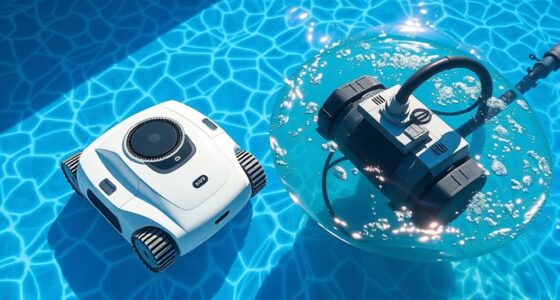To replace debris bags on pressure pool cleaners, start by turning off the system and locating the debris bag housing. Carefully detach the old bag, checking for tears or damage, and dispose of it properly. Insert a new bag, ensuring it’s securely fastened to prevent leaks or debris escape. Regularly inspecting and replacing your debris bag keeps your cleaner running efficiently—learn more tips to keep your pool spotless.
Key Takeaways
- Turn off the pool pump and pressure cleaner before removing the debris bag.
- Detach the old debris bag carefully, ensuring no debris spills.
- Check the new debris bag for tears or damage before installation.
- Securely attach the new debris bag to the cleaner, ensuring it is properly fitted.
- Restart the system and monitor for proper suction and operation.

Replacing debris bags on pressure pool cleaners is a straightforward task that helps guarantee your cleaner operates efficiently. When you’re tending to your pool, it’s essential to keep the debris bag clean and intact so that the cleaner can do its job effectively. Regularly checking and replacing the debris bag not only ensures ideal cleaning but also prevents strain on the motor, extending the lifespan of your equipment. As part of your routine maintenance, you should also focus on filter maintenance, since a clean filter supports proper water flow and suction. Proper filter upkeep ensures the debris bag functions efficiently and helps prevent troubleshooting tips like poor suction or incomplete cleaning. A clean filter and debris bag work together to maintain consistent water flow, which is vital for the cleaner’s performance. Additionally, understanding the importance of color accuracy in your equipment can help in diagnosing issues related to visibility or clarity during cleaning. Regularly inspecting the debris bag for tears or clogs can prevent potential damage to the system and promote optimal operation, especially since professional mechanic shops are known for their expertise in equipment maintenance. Keeping an eye on filter performance can further optimize cleaning efficiency and reduce the likelihood of equipment failure. Moreover, proper tuning of your pool cleaner can enhance its ability to handle different debris types more effectively. If you notice your pressure pool cleaner isn’t working as well as it should, don’t assume it’s a major problem. Often, troubleshooting tips involve simple steps like inspecting the debris bag for tears or clogs. Make sure the bag is securely attached and that there are no holes that could cause debris to escape or reduce suction. Also, check the hose for kinks or blockages, as these can hinder flow and cause the cleaner to underperform. Keeping an eye on these details helps you address common issues early without needing professional repair. Furthermore, ensuring your system features efficient filtration can enhance overall cleaning performance and prolong equipment life.
Frequently Asked Questions
How Often Should Debris Bags Be Replaced?
You should regularly check your debris bag as part of your maintenance schedule. Inspect the bag after each use to see if it’s full or clogged, which can impact cleaning efficiency. Typically, you’ll need to replace it every 1 to 3 months, depending on debris levels. Prompt bag inspection and replacement guarantee your pressure pool cleaner works effectively and keeps your pool pristine.
Can I Use a Generic Debris Bag Instead of the Manufacturer’S?
You might think using generic debris bags is fine, but it’s worth investigating compatibility considerations first. While some alternative debris options may seem convenient, they often lack the precise fit and filtration quality of manufacturer’s bags. Compatibility considerations can impact your cleaner’s performance and durability. To avoid damage or reduced efficiency, always check if the generic bag is designed for your specific pressure pool cleaner model before using it.
What Are Signs That the Debris Bag Needs Replacing?
You’ll notice the debris bag needs replacing when it loses bag elasticity, making it sag or feel stiff. If the bag’s capacity is nearly full and water flow slows or the cleaner struggles to operate efficiently, it’s time for a new one. Also, check for tears or holes. Regularly inspecting these signs ensures your cleaner works effectively and maintains ideal debris collection.
Is It Necessary to Turn off the Pool Pump Before Replacing the Bag?
Imagine the quiet hum of your pool pump suddenly stopping—that’s your cue to replace the debris bag. For pool pump safety, it’s best to turn off the pump before you start debris bag maintenance. This prevents accidental injury and keeps your equipment in top shape. Always verify the pump is off to avoid debris escaping or damaging the system during bag replacement, making the process safer and more efficient.
How Do I Properly Dispose of the Used Debris Bag?
When it comes to debris bag disposal, you should carefully remove the used bag from your pressure pool cleaner, making sure to avoid spilling debris. Seal the bag tightly and dispose of it in your regular trash bin, following your local waste disposal guidelines. Proper debris bag disposal helps maintain pool water quality and ensures effective pool water maintenance. Always wash your hands afterward to stay clean and safe.
Conclusion
Now that you know how to replace the debris bag, you’re almost ready to keep your pool spotless. But what if the bag seems fine, yet your cleaner’s performance drops? Could there be another hidden issue? Stay alert and keep an eye on your pressure cleaner’s behavior. Sometimes, the smallest detail can make all the difference. With your new skills, you’re prepared—yet the pool’s secrets might still surprise you. Are you ready to find out?









